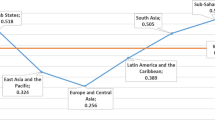Abstract
The present review is the first to be conducted since the adoption of UN 2030 Agenda for Sustainable Development; it examines the implementation of the PoA/ICPD in China since 1994 and its contributions to the achievement of the SDGs in China in the areas of population and development, gender equality, and health improvement. The review demonstrated that China has made tremendous progress in implementing the principles of the PoA in its national context over the past 25 years since ICPD in Cairo in 1994. Still, the ICPD agenda remains unfinished in some respects and further efforts are required, particularly given the changing situation in China.
Similar content being viewed by others
Notes
The official text of the call for “Two Reorientations” is as follows: “The family planning programme in China must make two reorientations in both its guiding ideology and programme approach, i.e., from a narrow focus on family planning alone to closely integrating it with economic and social development, and addressing population issues in a comprehensive manner; and from implementing the programme primarily relying on social constraints to gradually institutionalizing a mechanism to integrate rewards-driven with social constraints along with a coordinated IEC, comprehensive services, and scientific management” (Peng 1995).
The “six elements of quality of care” include providing adequate choice of contraceptive methods, introducing knowledge of contraceptive methods, competent technical skills, good interpersonal relationships, thorough follow-up services, and multifunctional reproductive health services (Bruce 1990).
The first six SFPC pilots on QoC, initiated in 1995, include Nong’an County of Jilin Province, Liaoyang County of Liaoning Province, Jimo City of Shandong Province, Yandu County of Jiangsu Province, Deqing County of Zhejiang Province, and Luwan District of Shanghai. The next five SFPC pilots on QoC experiment, initiated in 1997, include Xuanwu District of Beijing, Heping District of Tianjin, Xuanwu District of Nanjing, Zhuzhou City of Hunan Province, Liuyang County of Hunan Province.
Please refer to a length report on the reform, “Parental Discretion, China Tries Easing Once-Brutal Approach to Family Planning, As Population Growth Slows, The ‘Womb Police’ Yield to Ms. Liu’s Gentler Way. Is a ‘Two-Child’ Policy Next?”, published in the front page of The Wall Street Journal on February 2, 2001 (Chang 2001).
In fact, as a later part of this report explains, the one-child-per-couple policy is only a general description of China's family planning policy, which is factually more complicated than the one-child-per-couple policy in China (see Gu et al. 2007 for details). This report uses this customary statement here.
The World Bank has updated the international poverty line to USD 1.90 a day (in 2011 prices) since 2015. The previous line was USD 1.25 a day in 2005 prices. Poverty headcount ratio at USD 1.90 a day is the percentage of the population living on less than USD 1.90 a day at 2011 international prices.
The “4 Frees” are free anti-virus drugs and exposure to anti-virus treatment for HIV/AIDS patients who are rural residents or urban residents in economic hardship without participation in basic medical insurance; free counseling services and preliminary screening of HIV virus antibody for those voluntarily receiving HIV/AIDS counseling and virus testing; free provision of drugs blocking mother-to-infant transmission and infant test agents to pregnant women affected by HIV/AIDS; and free compulsory education for orphans of HIV/AIDS patients. “1 Care (一关怀)” refers to government care for treatment of people living with HIV/AIDS and HIV/AIDS patients, i.e., including HIV/AIDS patients and their families living in economic hardship in the scope of government subsidies and provide them with living allowances according to relevant social relief policies; and supporting people living with HIV/AIDS and HIV/AIDS patients to engage in income-generating activities as they are able.
References
Attane, I. (2016). The end of one child per family in China? Population and Societies. INED, No. 535, pp. 1–4.
Bongaarts, J., & Casterline, J. B. (2018). From fertility preferences to reproductive outcomes in the developing world. Population and Development Review,44(4), 793–809.
Bruce, J. (1990). Fundamental elements of the quality of care: A simple framework. Studies in Family Planning,21(2), 61–91.
Chang, L. (2001). Parental discretion, China tries easing once-brutal approach to family planning, as population growth slows, the ‘womb police’ yield to Ms. Liu’s gentler way. Is a ‘two-child’ policy next?. The Wall Street Journal. Front page, February 2.
Chen, R., & Gu, B. (2018). Historical turning or transient fluctuation: An empirical study about the natural change of household registered population in Shanghai. Exploration and Free Views,4, 109–115.
Gu, B. (2016). Population aging in China: A sketch. In C. Z. Guilmoto & G. W. Jones (Eds.), Contemporary demographic transformation in China, India and Indonesia (pp. 279–290). Switzerland: Springer International Publishing.
Gu, B. (2018). Fertility, reproductive health and population change with particular reference to China. In United Nations Expert Group Meeting for the Review and Appraisal of the Programme of Action of the International Conference on Population and Development and Its Contribution to the follow-up and review on the 2030 Agenda for Sustainable Development (pp. 1–2). New York: Population Division, Department of Economic and Social Affairs, United Nations Secretariat, 2018. https://www.un.org/en/development/desa/population/events/pdf/expert/28/EGM_Baochang_Gu.pdf.
Gu, B., & Hou, J. (2018). Why is China’s TFR so low? A decomposition analysis. Presented at Fertility across Time and Space: Data and Research Advances, Wittgenstein Center Conference 2018, 3rd Human Fertility Database Symposium (pp. 5–7). Vienna, Austria.
Gu, B., Wang, F., Guo, Z., & Zhang, E. (2007). China’s local and national fertility policies at the end of the twentieth century. Population and Development Review,33(1), 129–147.
Gu, B., Xu, Y., & Xie, Z. (1996). International new approach to reproductive health and family planning. Beijing: China Population Press.
Indian Institute of Health Management Research (IIHMR), the Ford Foundation China, the Ford Foundation New Delhi, the Population Council, and the University of Michigan. (1999). Indo-China dialogue on managing the transition to quality of care. New York: The Population Council.
Kaufman, J., Zhang, E., & Xie, Z. (2006). Quality of care in China: From pilot project to national program. Studies in Family Planning,37(1), 17–28.
Ministry of Education (MOE). (2006). Educational statistics yearbook of China 2005. Beijing: Department of Development and Planning, People’s Education Press.
Ministry of Education. (MOE). (2018). Educational statistics yearbook of China 2017. Beijing: Department of Development and Planning, People’s Education Press.
Ministry of Education (MOE). (2018b). 2017 National statistical report on education development. Retrieved October 20, 2019 from http://www.moe.gov.cn/jyb_sjzl/sjzl_fztjgb/201807/t20180719_343508.html.
Ministry of Health (MOH). (2005). China health statistics yearbook 2005. Beijing: Chinese Peking Union Medical College Press.
National Bureau of Statistics (NBS). (1996). China population statistics yearbook 1996. Beijing: Department of Population and Employment Statistics, China Statistics Press.
National Bureau of Statistics (NBS). (2000). Tabulation on the 2000 population census of the PRC. Retrieved October 20, 2019 from http://www.stats.gov.cn/tjsj/ndsj/renkoupucha/2000pucha/pucha.htm.
National Bureau of Statistics (NBS). (2001). China statistical yearbook 2001. Retrieved October 20, 2019 from http://www.stats.gov.cn/tjsj/ndsj/2001c/u2135c.htm.
National Bureau of Statistics (NBS). (2008). Social progress in 2008 (nation-wide). Beijing: Department of Social, Science and Technology Statistics.
National Bureau of Statistics (NBS). (2009). China population and development report 2009—From ICPD to MDG. A review for China at 15 years (1994–2009).
National Bureau of Statistics (NBS). (2012). Women and men in china—Facts and figures. Beijing: Department of Social, Science and Technology, Culture Statistics National Bureau of Statistics.
National Bureau of Statistics (NBS). (2018). China statistical yearbook 2018. Retrieved October 20, 2019 from http://www.stats.gov.cn/tjsj/ndsj/2018/indexch.htm.
National Bureau of Statistics (NBS). (2019a). Statistics on the situation of women and children in China (2018). Beijing: Department of Statistics, Social Science and Cultural Industry, China Statistics Press.
National Bureau of Statistics (NBS). (2019b). National economy and society developed statistical bulletin 2018. Retrieved October 20, 2019 from http://www.stats.gov.cn/tjsj/zxfb/201902/t20190228_1651265.html.
National Health Commission (NHC). (2018). China health statistics yearbook 2018. Beijing: Chinese Peking Union Medical College Press.
National Health Commission (NHC). (2019a). China women and children health care development report (2019). Beijing.
National Health Commission (NHC). (2019b). Statistical bulletin on China’s health in 2018. Beijing.
Partners in Population and Development (PPD). (2011). Sharing innovative experiences, volume 19: Experiences in addressing population and reproductive health challenges. Cairo: Global South-South Development Academy.
Partners in Population and Development (PPD). (2019). South-South cooperation in catalyzing achievement of ICPD and SDGs 2030 Agenda. Dhaka, Bangladesh. Retrieved October 20, 2019 from http://www.partners-popdev.org/wp-content/uploads/2019/06/South-South-Cooperation-Book-File.pdf.
Peng, P. (1995). A speech at the national symposium on exchanges of experiences of ‘three integrations’ in family planning. China Family Planning Yearbook,1996, 25.
Peng, P. (1998). A speech at the central seminar on family planning and environment protection. China Family Planning Yearbook,1998, 10–11.
Scharping, T. (2018). Abolishing the one-child policy: Stages, issues and the political process. Journal of Contemporary China. https://doi.org/10.1080/10670564.2018.1542217.
Simmons, R., Fajans, P., & Ghiron, L. (Eds.). (2007). Scaling up health service delivery: From pilot innovations to policies and programmes. Geneva: World Health Organ.
Simmons, R., Hall, P., Diaz, J., Diaz, M., Fajans, P., & Satia, J. (1997). The strategic approach to contraceptive introduction. Studies in Family Planning,28(2), 79–94.
The State Council of PRC. (2011). Outline of the twelfth five-year plan for national economic and social development. Retrieved October 20, 2019 from http://www.npc.gov.cn/wxzl/gongbao/2011-08/16/content_1665636.htm.
United Nations Development Programme (UNDP). (2018). Human development reports (2018 Statistical Update). Retrieved June 24, 2019 from http://hdr.undp.org/en/2018-update.
Wang, F., Cai, Y., & Gu, B. (2013). Population, policy, and politics: How will history judge China’s one-child policy? Population and Development Review,38(Suppl.), 115–129.
Wang, F., Gu, B., & Cai, Y. (2016). The end of China’s one-child policy. Studies in Family Planning,47(1), 83–86.
Wang, G., & Wang, J. (2019). Population situation and demographic development trends in contemporary China. Journal of Social Development (Quarterly),6(1), 1–20.
World Bank. (2018). World development indicators database. https://data.worldbank.org/indicator/SL.TLF.CACT.FE.ZS?locations=CN&most_recent_value_desc=false.
Xi, J. (2015). On explanation of the proposed 13th five-year plan. Xinhua News Agency. Retrieved October 20, 2019 from http://www.xinhuanet.com//politics/2015-11/03/c_1117029621.htm.
Xie, Z. (2011). Focusing on quality of care in the family planning program. In The Partners in Population and Development (PPD) (Ed.), Sharing innovative experiences, volume 19: Experiences in addressing population and reproductive health challenges (pp. 47–71). Cairo: Global South-South Development Academy.
Xie, Z. (2018). Logical framework of quality of care in family planning in China: client-centered approach. China Population and Development Studies,2(2), 224–244.
Xie, Z., Gu, B., Zheng, Z., Liu, H., & Ru, X. (Forthcoming). Efforts in memory: Quality of care initiative in China’s family planning programme. Beijing: Social Science Literature Press.
Xie, Z., & Tang, M. (2011). From population control to reproductive health: Evolution of China’s family planning program. In Zhang Kaining (Ed.), Sexual and reproductive health in China (pp. 1–36)., Reorienting concepts and methodology Boston: Brill.
Zhang, E., Gu, B., & Xie, Z. (Eds.). (1999). Assessment reports on the SFPC’s first pilot counties/district on quality of care in family planning (1995–1998). Beijing: China Population Press.
Zheng, Z. (2018). National Report for the Mid-Term Review of the Sixth Asian and Pacific Population Conference. The Country Report Used for the 2018 Mid-review of Asia Pacific Population Conference (APPC).
Acknowledgements
This report is financially supported by the United Nations Population Fund (UNFPA) (Grant No. 0000138623) in China as part of its collaboration with the China Population and Development Research Centre (CPDRC), but the views expressed herein are those of the authors, and do not necessarily represent those of the United Nations or any government bodies or institutions. The authors wish to express their sincere gratitude to those who have contributed significantly to this report: Mme. Hongyan Liu, Deputy Director-General, Mrs. Mengjun Tang and Mr. Zhixin Wei from the China Population and Development Research Center for their efficient supports; Mr. Hongtao Hu, Prof. Zhenming Xie and Mr. Yunpeng Wei for their valued suggestions. The authors also wish to thank the UNFPA team in China country office—Dr. Babatunde Ahonsi, Representative of UNFPA in China, Ms. Suren Navchaa, Deputy Representative of UNFPA in China, and Dr. Guoping Jia, Programme Specialist for Population and Development in UNFPA in China—for their valuable insights.
Author information
Authors and Affiliations
Corresponding author
Rights and permissions
About this article
Cite this article
Gu, B., Mao, Z. & Hu, M. An ongoing journey: review of ICPD + 25 in China. China popul. dev. stud. 4, 1–24 (2020). https://doi.org/10.1007/s42379-020-00044-8
Received:
Accepted:
Published:
Issue Date:
DOI: https://doi.org/10.1007/s42379-020-00044-8




